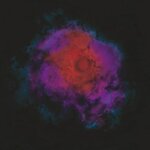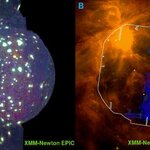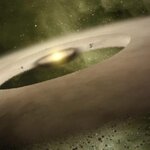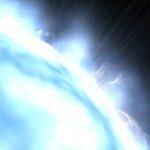Space

Images from NASA-funded telescopes aboard a Japanese satellite have shed new light about the sun's magnetic field and the origins of solar wind, which disrupts power grids, satellites and communications on Earth.
Data from the Hinode satellite shows that magnetic waves play a critical role in driving the solar wind into space. The solar wind is a stream of electrically charged gas that is propelled away from the sun in all directions at speeds of almost 1 million miles per hour. Better understanding of the solar wind may lead to more accurate prediction of damaging radiation waves before they…

A dwarf star with a surprisingly magnetic personality and a huge hot spot covering half its surface area is showing astronomers that life as a cool dwarf is not necessarily as simple and quiet as they once assumed.
Simultaneous observations made by four of the most powerful Earth- and space-based telescopes revealed an unusually active magnetic field on the ultracool low-mass star TVLM513-46546. A team of astronomers, led by Dr. Edo Berger, a Carnegie-Princeton postdoctoral fellow at Princeton University, is using these observations to explain the flamboyant activity of this M-type dwarf…

University of British Columbia astronomer Harvey Richer and UBC graduate student Saul Davis have discovered that white dwarf stars are born with a natal kick, explaining why these smoldering embers of Sun-like stars are found on the edge rather than at the centre of globular star clusters.
White dwarfs represent the third major stage of a star’s evolution. Like the Sun, each star begins its life with a long stable state where nuclear reactions take place in the core supplying the energy. After the core fuel is depleted, it swells up and turns into a huge red giant. Later, the red giant ejects…

Perhaps the first stars in the newborn universe did not shine, but instead were invisible “dark stars” 400 to 200,000 times wider than the sun and powered by the annihilation of mysterious dark matter, a University of Utah study concludes.
The study – to be published next month in the journal Physical Review Letters – calculated how the birth of the first stars almost 13 billion years ago might have been influenced by the presence of dark matter – the unseen, yet-unidentified stuff that scientists believe makes up most matter in the universe.
The findings “drastically alter the current…

Messier 74, also called NGC 628, is a stunning example of a 'grand-design' spiral galaxy that is viewed by Earth observers nearly face-on. Its perfectly symmetrical spiral arms emanate from the central nucleus and are dotted with clusters of young blue stars.
In the new Hubble image we can also see a smattering of bright pink regions decorating the spiral arms. These are huge, relatively short-lived, clouds of hydrogen gas which glow due to the strong radiation from hot, young stars embedded within them; glowing pink regions of ionized hydrogen (hydrogen that has lost its electrons). These…

Right in time for the festive season, ESA's XMM-Newton X-ray observatory has discovered a huge cloud of high-temperature gas resting in a spectacular nearby star-forming region, shaped somewhat like the silhouette of Santa Claus.
An early present for astronomers, the cloud suggests that hot gas from many star-forming regions leaks into the interstellar medium.
The Orion nebula is the nearest dense star-forming region to Earth that contains stars much more massive than the Sun. XMM-Newton’s newly-discovered gas cloud is composed of winds blowing from these high-mass stars that are heated to…

Astronomers at the University of Illinois have found the first clear evidence for a cradle in space where planets and moons form. The cradle, revealed in photographs taken with NASA’s Spitzer Space Telescope, consists of a flattened envelope of gas and dust surrounding a young protostar.
“We are seeing this object in the early stages of stellar birth,” said U. of I. astronomy professor Leslie Looney, the lead author of a paper accepted for publication in Astrophysical Journal Letters. “Eventually, the protostar will form into a star much like our sun, and the disk will form into planets and…

Astronomers at the University of Michigan have found what are believed to be some of the youngest solar systems yet detected.
The systems are around the young stars UX Tau A and LkCa 15, located in the Taurus star formation region just 450 light years away. Using a telescope that measures levels of infrared radiation, the researchers noticed gaps in the protoplanetary disks of gas and dust surrounding these stars. They say those gaps are most likely caused by infant planets sweeping those areas clear of debris.
A paper on the findings by astronomy doctoral student Catherine Espaillat,…

One of the fastest moving stars ever seen has been discovered with NASA's Chandra X-ray Observatory. This cosmic cannonball is challenging theories to explain its blistering speed.
Astronomers used Chandra to observe a neutron star, known as RX J0822-4300, over a period of about five years. During that span, three Chandra observations clearly show the neutron star moving away from the center of the Puppis A supernova remnant. This remnant is the stellar debris field created during the same explosion in which the neutron star was formed about 3700 years ago.
By combining how far it has moved…

Astronomers have discovered white dwarf stars with pure carbon atmospheres. The discovery could offer a unique view into the hearts of dying stars.
These stars possibly evolved in a sequence astronomers didn't know before. They may have evolved from stars that are not quite massive enough to explode as supernovae but are just on the borderline. All but the most massive two or three percent of stars eventually die as white dwarfs rather than explode as supernovae.
When a star burns helium, it leaves "ashes" of carbon and oxygen. When its nuclear fuel is exhausted, the star then dies as a white…